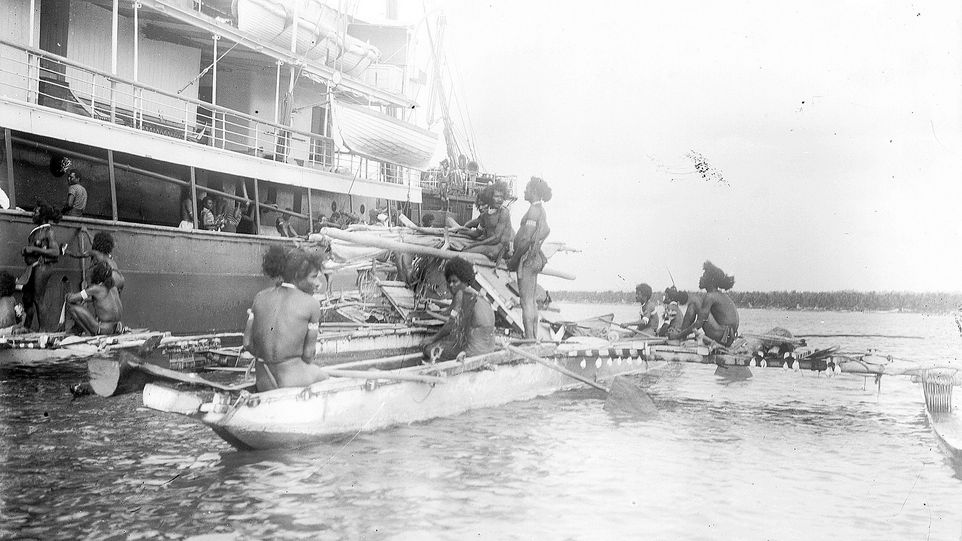
Colonial history of North German Lloyds

As one of the largest shipping companies in the German Empire, Norddeutscher Lloyd plays an important role in the investigation of the history of colonial objects.
03/03/2021 · Geisteswissenschaften und Bildungsforschung · Deutsches Schifffahrtsmuseum - Leibniz-Institut für Maritime Geschichte · News · Projekte
As one of the largest shipping companies in the German Empire, Norddeutscher Lloyd (NDL) plays an important role in the exhibition and research program of the German Maritime Museum / Leibniz Institute for Maritime History (DSM). The German Center for Cultural Heritage Losses has approved a research project related to the history of the NDL as a big player in colonialism. In this project, the DSM cooperates with the Übersee-Museum Bremen and the Südsee-Sammlung Obergünzburg.
From the second half of the 19th century onwards, European military personnel, scientists and merchants brought various cultural and everyday objects from the then colonies to their home countries. What brought them to which institutions, whether they were bought, exchanged, or looted, is now being more critically examined worldwide. Using the example of Pacific collections related to the NDL, the DSM and its cooperation partners are investigating these questions.
During the height of imperialism, the NDL advanced to become one of the world's largest shipping companies, transporting goods from a wide variety of countries to European ports. Many of the objects in the DSM's holdings date from the time of the German Empire. In most cases, their colonial contexts have not yet been clarified. Therefore, this research project aims to create a new perspective and investigates the role that such shipping companies as the NDL played in the creation of museum collections.
At that time, natural history and ethnological collections were gathered and then stored in european museums, but also at universities, which all were dependent on the transport of objects by ship. One aim of the project is to reconstruct the routes by which these objects travelled to Europe. The project manager Prof. Dr. Ruth Schilling emphasizes: "Research into these difficult circumstances requires both detective skills and knowledge of maritime history, and our staff at the DSM have both.
The DSM offers a special starting point that allows us to look at the logistical relationships between objects and the history of the historical agenty together by tracing the routes of ships. Complementary to this, the Südsee-Sammlung Obergünzburg holds, for example, the estate of Captain Karl Nauer, a captain who worked in the services of the NDL in the colony of German New Guinea. The Übersee-Museum in Bremen also acquired and shipped numerous objects from the South Seas in close cooperation with the NDL. Archival materials such as postcards, photographs, and literature document these processes.
It also remains to be investigated what role shipping as such played in the selection of the exported objects - and to what extent it was the shipping itself that justified the production of some objects in the first place. In this context, it would be helpful to look at both the objects and the conditions of transport: "How large is an object, does it fit on a ship, how can it be packaged or labelled? We want to check our inventory to see what information we can draw from it, what effects the infrastructure of the time had, and what political developments went along with it".
The project pursues both the goals of working up colonial history using shipping as an example and of obtaining more precise information about the respective collection objects. On the one hand, the trade in objects is to be examined, on the other hand, the perspective of the societies of origin is to be more clearly represented. "An adequate reappraisal of colonial contexts is not conceivable without support of members of the societies affected by this," says Tobias Goebel, who is a scientific project staff member at the DSM and acts as a contact person. "We would like to develop further cooperation to discuss the project together and make the results available on an international basis”. A central position within the project will therefore be filled by an International Fellow, the artist and curator Lisa Hilli.
My key interests within this project are photographic and plantation history within German New Guinea. Working with DSM and other institutional staff, I also hope to expand my understanding of the movement of Asian and Pacific bodies to and from Rabaul via German ships. It’s important to make German colonial history transparent and accessible to all communities globally relating to German New Guinea, particularly my own Gunantuna (Tolai) community. Participating in this collections based research project will greatly enhance my on-going creative research interests in labour and trade relationships as sites of transformation during the colonial period.
Taking these aspects into consideration, questions of image and object effects will also be in the focus of the investigations. With the transfer of objects, they themselves changed their cultural function. While taken out of their original context of use, to European Museums they served as representatives of foreign cultures. Today, the history of colonial objects is a socially and politically controversial topic to which the DSM will make its contribution with this research project. The start of the research project on the history of the NDL as a big player in colonialism, funded by the German Center for Cultural Property Losses, is April 1, 2021.